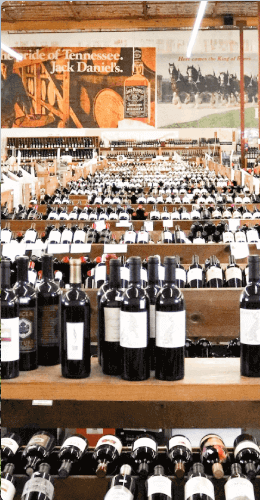Hidden Magic: How Cellar Climate Impacts Barrel-Aged Wine

For wine enthusiasts, the allure of a well-aged bottle is irresistible. The transformation of youthful, vibrant wine into a complex, harmonious elixir is a testament to the magic of time and the art of winemaking. However, behind the scenes, the cellar's climate plays a pivotal role in shaping the destiny of barrel-aged wine. Let’s delve into the intricate dance between cellar climate and wine, exploring how temperature, humidity, and other environmental factors impact the aging process, and ultimately, the flavors that grace our glasses after we buy wine online.
The Wine Cellar
Before we explore the nuances of cellar climate, it's essential to understand the basics of barrel aging. Once wine is fermented and initially aged in stainless steel or concrete tanks, it often finds its way into oak barrels for further maturation. This secondary aging stage can last anywhere from several months to several years, during which time the wine undergoes a series of chemical reactions that refine its character and depth.
The climate within the wine cellar plays a vital role in determining how these reactions unfold. Let's delve into the factors that influence barrel-aged wine's development. Temperature is the conductor of the aging symphony in the wine cellar. It influences the speed and nature of chemical reactions within the wine. Cellar temperature is usually measured in degrees Celsius or Fahrenheit, but it's the consistency of temperature that truly matters.
Wine aging thrives on stability. Fluctuations in temperature can lead to expansion and contraction of the liquid, causing it to move in and out of the wood of the barrel. This movement, often called "breathing," allows the wine to extract flavors and compounds from the oak. However, excessive fluctuations can disrupt the aging process and lead to oxidation or unwanted microbial activity. Most wine cellars maintain temperatures between 50-59°F (10-15°C). This range is considered ideal for aging a wide variety of wines, from reds to whites. Cooler cellars slow down aging, while warmer cellars accelerate it. Specific temperature preferences may vary depending on the wine type and producer. Humidity levels within the wine cellar are a critical, yet often overlooked, factor. Maintaining proper humidity helps preserve the integrity of the wine and the barrels.
Wine aging is not a one-way street. As wine ages, some of it naturally evaporates through the barrel, creating what winemakers poetically refer to as the "angels' share." Proper humidity levels help minimize this loss, ensuring that the wine remains concentrated and expressive.
Light and Vibration: Silent Enemies
While temperature and humidity are well-known players in the aging process, other factors, such as light and vibration, also exert their influence. Ultraviolet (UV) rays in sunlight can prematurely age and damage wine. This is why cellars are typically dimly lit, and bottles are often stored horizontally to minimize surface area exposed to light. Constant vibration, such as that caused by machinery or heavy traffic, can agitate sediment within wine bottles and barrels. This can negatively impact wine clarity and texture over time. Cellars are often designed to be vibration-free sanctuaries.
The Role of Oak
Oak barrels are the stage on which the aging drama unfolds. The type of oak, the toast level of the barrels, and their age all contribute to the flavor profile of the final wine.
- Oak Type: Different oak species, such as French, American, and Hungarian, impart distinct flavors and aromas to the wine. French oak, for example, tends to add more subtle and elegant notes, while American oak offers bolder and spicier characteristics.
- Toasting Levels: The degree to which barrels are toasted can vary. Light toasting might introduce delicate vanilla and coconut nuances, while heavy toasting can contribute smoky, caramel, and roasted coffee flavors.
- Barrel Age: The age of the oak barrels also matters. New barrels impart the most oak influence, while older ones have a milder impact. Winemakers often choose the age and type of barrel to complement the wine's varietal and style.
Within the cellar's microcosm, various microorganisms silently contribute to the wine's complexity. Yeasts, bacteria, and molds interact with the wine, often in symbiosis with oxygen, to create nuanced aromas and flavors.
Brettanomyces, commonly referred to as "Brett," is a yeast strain can either enhance or ruin a wine, depending on its levels and the winemaker's intentions. In small amounts, Brett can add complexity with notes of earth, leather, and spice. However, excessive Brett can lead to off-putting aromas and flavors.
Aging Potential: Certain wines, especially those intended for long aging, are more tolerant of microbial activity. Winemakers must strike a balance between allowing these microorganisms to contribute to the wine's complexity and preventing them from taking over.
The world of barrel-aged wine is a delicate dance between science and artistry, with the cellar's climate as the conductor of this symphony. Temperature, humidity, light, and oak all influence the wine's evolution, as do microbial players, from the subtle to the potentially disruptive.
For wine enthusiasts, understanding the impact of cellar climate on barrel-aged wine deepens the appreciation of the artistry and craftsmanship that goes into each bottle. Whether savoring a silky Pinot Noir aged in French oak or a robust Cabernet Sauvignon from American barrels after wine delivery California, knowing how these factors shape the wine's character adds a layer of complexity to the tasting experience. So, the next time you enjoy a perfectly aged bottle, raise your glass to the unseen maestro—the wine cellar's climate—that has shaped this liquid masterpiece over time.


















Leave a comment